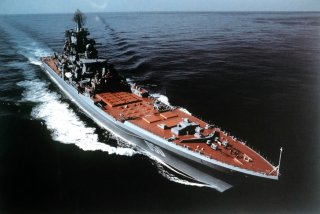Russia's Old Battlecruiser Could Strike With 60 Hypersonic Missiles
Could this kind of attack pose a risk to the continental United States?
Should Russia truly be arming its upgraded 1980s battle cruiser, the Admiral Nakhimov, with up to sixty hypersonic missiles, then many NATO countries and the United States could face a massive and potentially unparalleled threat.
A Forbes article from last year says the ship will be armed with the 3M22 Zircon hypersonic missiles, weapons smaller and much faster than the ship’s legacy P-700 Granite missiles. This means, according to the report, that three Zircon hypersonic missiles could be carried for each Granite, arming the ship with a total of sixty missiles. This kind of hypersonic attack volume could overwhelm and potentially destroy surface ships, enemy coastal defenses and even fortified inland targets with a salvo of hypersonic strikes at one time. Ship-fired hypersonics offer a tactical proximity not available to standard conventional ground forces, given the speed with which they travel. At first thought, for instance, this kind of sea-launched weapon would seem very well positioned to overwhelm or attack NATO countries along or near the Black Sea such as Albania.
Even upgraded air defenses are likely to have considerable trouble defending against that kind of attack, as pretty much most available defenses would likely be fully overwhelmed by large numbers of incoming hypersonic missiles traveling more than five times the speed of sound. This kind of threat is likely something considered extremely dangerous, as a volley of hypersonic missile attacks from the ocean could, for instance, take out air defenses to quickly open up an air corridor for a follow-on aerial attack.
Extending thinking about this kind of scenario, it would not just be areas along the black sea at risk, as large battlecruisers of this kind would be positioned for long-range travel into locations quite far from Russian shores. Could this kind of attack pose a risk to the continental United States? That might be possible.
So how to defend against this outcome? While there are likely many kinds of defenses against hypersonic missiles being fast-tracked, there does not appear to be anything available now that might operate with an ability to stop this kind of attack. Would ship-armed interceptor missiles be fast enough? It's unclear. This is most likely one reason the Pentagon is fast-tracking a large number of hypersonic weapons programs and moving quickly with testing. Not only could this introduce the notion of a hypersonic, high-speed “interceptor” to stop hypersonic attacks, but it would certainly function as a deterrent by ensuring the promise of a massive similar hypersonic counterattack against the aggressor. Also, hypersonic missiles are known to operate at very long ranges. However, it may not be clear just how far they can travel when fired from a ship. Nonetheless, one potential defensive strategy might be to simply hold the battlecruiser itself at risk of massive counterattack by tracking its path from the air with satellites, drones and even attack aircraft.
Kris Osborn is the defense editor for the National Interest. Osborn previously served at the Pentagon as a Highly Qualified Expert with the Office of the Assistant Secretary of the Army—Acquisition, Logistics & Technology. Osborn has also worked as an anchor and on-air military specialist at national TV networks. He has appeared as a guest military expert on Fox News, MSNBC, The Military Channel, and The History Channel. He also has a Master’s Degree in Comparative Literature from Columbia University.
Image: Reuters

